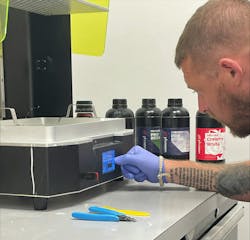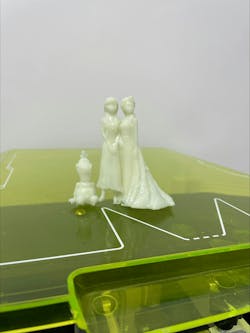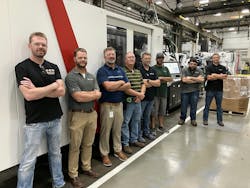Problem: Customers have shied away from prototyping, eschewing its benefits in favor of the possibility of saving time and money.
Solution: A new cost-effective, entry-level 3D printer capable of printing mold cavities from a ceramic material has given one molder the ability to quickly turn around first-run parts.
By Karen Hanna
American Plastic Molding (APM) is a company on a mission. With current annual sales pegged at over $20 million, it’s set its sights on more. Within 10 years, it wants to hit $50 million, said Adam Auffart, the company’s VP of sales and marketing.
But doing so takes investment — and the company is doubling down, with recent machinery acquisitions that are allowing it to offer even more services and capabilities, from a new 3D printer to its biggest-ever injection molding machine (IMM). To speed up quality control over the parts it makes, the Scottsburg, Ind., custom molding shop, which employs over 100 people, also has invested in a new scanner.
One avenue of growth APM is pursuing is access to prototyping — a process Auffart said he has seen customers increasingly neglect, in the interest of saving time and money.
“I feel like early in my career, which [has spanned] 20-plus years now, there was a lot of prototyping going on, way back when. And now, it doesn’t seem like people prototype nearly as much,” he said. “It’s the cost and the time associated with that, I think, that’s kind of driven that out.”
But not prototyping carries its own risks, Auffart observed.
“It’s pay now or pay later,” he said.
APM is looking at ways to help its customers balance the drawbacks between prototyping, which can be time-consuming, and skipping the prototyping process, which can leave customers stuck with substandard parts. The release of BASF’s Ultracur 30 RG3280 rigid photopolymer material appropriate for 3D printing, along with the availability of cost-effective 3D printers capable of making molds, has created new possibilities for the molding shop, which serves a wide array of market segments, including the automotive, power-generation and materials-handling industries.
In the spring, APM “dipped our toe a little” into 3D printing, with its acquisition of a Mega 8K S liquid-crystal-display resin 3D printer from Phrozen, Auffart said. Costing around $1,000, the printer is an affordable starter technology as APM learns what’s possible with additive manufacturing.
The company already has run trials for customers and molded parts using ceramic cavities produced with the printer.
Small-volume jobs represent another possible application.
Capable of running ceramics, as well as high-temperature, durable resin materials appropriate for molds, Phrozen’s printers increasingly are being used in molds and mold components for prototyping and small-batch production, according to the company.
The speed and flexibility of 3D printers represent a win for customers, with the possibility “to just completely take the risk and the cost out of it, which will be phenomenal,” Auffart said.
“Making that gap and cost and time shorter, I think, will help companies go back to a little bit of trial and error ... especially with brand-new products,” he said.
He acknowledged that APM still is learning about 3D printing — “the thermodynamics are different than steel”— but he’s excited for the possibilities.
“This has been talked about for a long time, and there’s always been limitations on the material, was always kind of the issue. And now I feel like it’s gotten started to where it seems to be very promising,” he said.
Upgrading the IMM fleet
APM, which runs three shifts a day, five days a week, also is investing in more-traditional technologies, with a robust replacement plan that favors ensuring its 42 IMMs are “as new and up to date as possible,” he said.
The latest to be replaced was a 725-ton IMM — with a new, more-compact 900-ton M-series IMM that fills the same space. It’s from Milacron, which has supplied all of APM’s presses.
“Now, we can go offer our customers bigger parts, or bigger shot size and some more capabilities,” he said.
Alec Woll, product manager for the M- and C-series platforms for Milacron, said customers are looking to squeeze as much as they can out of every square foot.
“This is becoming more and more important in the current economic climate. Customers are wanting to maximize their floor space with as many machines as possible without expanding their floor,” he said.
Milacron reduced the length of its 900-ton M-series presses by redesigning the machines’ clamp end. It also transitioned from a 2.5-platen design to a true two-platen design and built in tonnage capacity on the stationary platen, Woll said.
That’s offered benefits that go beyond space savings, he said.
“This ties back to lower energy consumption on the clamp half due to less mass traveling back and forth with every cycle,” he said.
Acquiring all of its presses from one supplier has streamlined training, maintenance and operations for APM, and with the plant and Milacron just a couple miles down the road from each other, service and parts are easily accessible, Auffart said.
Molders benefit from having a tight relationship with their IMM supplier, both Auffart and Woll noted.
“This makes it extremely easy to train operators with the same equipment because we are going on 10 years with the same control, continuing to improve the control, for tonnages above 500 [tons]. The machines may look different, but the functionality of the machine is very similar,” Woll said via email. “The maintenance factor is one of Milacron’s value-adds, as well, since we design for serviceability. We want to ensure that when there is a problem, it can be fixed quickly without tearing apart the machine to locate the issue(s).”
Offering IMMs with clamp forces from 900 tons down to 110 tons fits APM’s vision of providing a diverse array of capabilities to its customers. Among other services, it also offers design, decoration, assembly and other services.
“Some companies like to just mold parts and have them out the door; we tend to like to find opportunities that allow us to do more value-added work,” Auffart said.
With customers that include Pioneer Electronics, office-furniture supplier Steelcase, generator company Generac and auto-parts supplier Magna, APM is quality-focused, too. In November, it added a VL-700-series 3D scanner with 360-degree scanning capabilities from Keyence.
“It’s been a very valuable tool for us to be able to quickly measure things that are complex parts that would take a long time to measure with either a CMM or an optometer, or even with calipers. So, this machine has really been pretty amazing so far,” Auffart said. “And we’re really just sort of scratching the surface on its capabilities.”
Turning potential into reality with new technologies is all part of the ambitious growth plan for the company, which in early September was ready to begin making parts that would have been too big for the 725-ton machine the 900-tonner replaced.
“We actually have a new project we need to be able to use the new machine for as soon as it is greenlit,” Auffart said shortly before the new press had entered operation. “So, the press will be needed immediately to accommodate this new job. It is the largest press we have had, and we are super-excited!”
The arrival of the press — like the adoption of the other new technologies — opens up new possibiities for APM.
“We’re focusing a lot of energy on finding new customers and new programs, investing in technology, like this machine and other things that really put us in a position to be competitive when we go lock down those new opportunities,” Auffart said.
In an update in September, APM was one step closer in its growth plan.
“The press is running production this week in fact! “ Auffart said in an email update. “Overall, the install went well, and Milacron techs were great to work out all the small bugs that inevitably go along with a project of this size and scope.”
Contact:
Keyence Corp. of America, Itasca, Ill., 888-539-3623, www.keyence.com
Milacron LLC, Batavia, Ohio, 513-536-2000, www.milacron.com
Phrozen Tech Co. Ltd., Hsinchu City, Taiwan, https://us.phrozen3d.com
About the Author
Karen Hanna
Senior Staff Reporter
Senior Staff Reporter Karen Hanna covers injection molding, molds and tooling, processors, workforce and other topics, and writes features including In Other Words and Problem Solved for Plastics Machinery & Manufacturing, Plastics Recycling and The Journal of Blow Molding. She has more than 15 years of experience in daily and magazine journalism.


